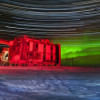Surprising amount of water ice found on Pluto’s surface

A new map of the dwarf planet revealed that water ice is surprisingly abundant on Pluto's surface.
Scientists created the map using data collected by NASA's New Horizons spacecraft during its epic flyby of Pluto last July, reports Space.com.
The new map is more sensitive than an earlier version also produced using flyby observations, and thus shows more water ice — the dwarf planet's bedrock material — cropping up across Pluto's surface than had been seen previously, reports the online portal quoting NASA officials.
"But despite its much greater sensitivity, the map still shows little or no water ice in the informally named places called Sputnik Planum (the left or western region of Pluto's 'heart') and Lowell Regio (far north on the encounter hemisphere)," NASA officials wrote in a statement Thursday (Jan 28).
"This indicates that at least in these regions, Pluto's icy bedrock is well hidden beneath a thick blanket of other ices such as methane, nitrogen and carbon monoxide."
New Horizons zoomed within just 7,800 miles (12,550 kilometers) of Pluto on July 14, 2015, returning history's first up-close looks at the dwarf planet and its five moons.
The new and old water-ice maps were both made using infrared-light observations captured by New Horizons' Ralph/Linear Etalon Imaging Spectral Array (LEISA) instrument, at a distance of about 67,000 miles (108,000 km) from Pluto, NASA officials said.
New Horizons is currently zooming toward a small object about 1 billion miles (1.6 billion km) beyond Pluto called 2014 MU69. If NASA approves and funds a proposed extended mission, the spacecraft will study 2014 MU69 up close on Jan. 1, 2019.
New Horizons is also still beaming home the many photos and measurements it captured during the July 14 flyby. All of the close-encounter data should be on the ground by this coming fall, mission team members have said.

 For all latest news, follow The Daily Star's Google News channel.
For all latest news, follow The Daily Star's Google News channel. 








Comments